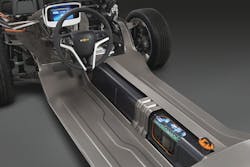SUBJECT: Electric Vehicles
TOPIC: Part 2 – 2011 Chevrolet VOLT Battery
OBJECTIVE: Given a potential scenario involving a 2011 Chevrolet VOLT, the emergency responder team will understand the components of the vehicle's high-voltage and 12-volt electrical system
TASK: The rescue team shall study the 2011 Chevrolet VOLT information provided along with conducting a tour and inspection of a vehicle at a Chevrolet dealership to adequately become familiar with management of the vehicle's 12-volt and high-voltage electrical system.
The Chevrolet VOLT is classified as an electric vehicle with extended range. It utilizes a 400-pound high-voltage battery to power its front drive wheels. The T-shaped lithium-ion high-voltage battery is truly the heart of the vehicle's propulsion system. Responders must understand what this battery does, what it is constructed of and where it is located in order to ensure that any incident involving a VOLT in a crash or fire scenario will be handled safely and efficiently.
The Chevrolet VOLT is a plug-in electric vehicle. The VOLT is propelled only by electricity, although it has an eight-gallon metal fuel tank that supplies a gasoline-powered electric generator built into the vehicle. Using electricity, the VOLT can travel up to 40 miles on a full charge of its onboard high-voltage battery. To travel an additional distance, the electric generator produces electricity for the VOLT to travel approximately 300 extra miles. The operator of the VOLT can plug the car into a 120-volt AC or 240-volt outlet to recharge the onboard high-voltage battery. A special charging cord plugs into a charging port connection on the driver's front fender. This allows the high-voltage battery to recharge within either an eight-hour (120 volts) or three-hour (240 volts) period.
The 400-pound, 360-volt DC high-voltage battery unit is a T-shaped assembly that resides in the center tunnel area extending beneath both the center console and rear seats of the vehicle. The long section of the battery pack runs lengthwise beneath the center console. The top of the T-shaped pack fits underneath the rear seat. The VOLT high-voltage battery is rated at 360 volts DC and 16kWh of energy. The battery's 288 cells are liquid cooled to maximize operating efficiency. The battery cell modules are attached to a metal tray that is bolted to the underside of the body structure.
The high-voltage battery pack cover is made of a non-metallic, sheet-molded compound. All electrical and coolant connections to the battery are made at a single location on the front face of the pack. In the event that this high-voltage lithium-ion battery becomes involved in a vehicle fire scenario, copious amounts of water are necessary to cool and extinguish the fire. Self-contained breathing apparatus (SCBA) should be used continuously until all smoldering has ceased and the vehicle and battery is cooled.
An orange-colored manual service disconnect plug is located on the top surface of the battery pack. By lifting a small storage bin on top of the center console, this manual plug is accessible. The plug can be disconnected and manually removed as an alternative means for responders to confirm the voltage from the high-voltage battery is contained within the battery itself.
Because the Chevrolet VOLT uses electrical voltage of 360 volts DC, all high-voltage cabling throughout the entire vehicle is bright orange in color. The cable is very well designed. It is double-insulated with an inner core that actually carries the electrical current. Surrounding that is a plastic cover. Around this covering is a metal mesh sheathing. The vehicle measures electrical isolation fault through this mesh. If anything breaks, tears, or disconnects this mesh, the electrical control system senses it and shuts off the high-voltage current coming from the battery.
The outer covering is bright orange color that is very visible for responders arriving at a VOLT incident.
The VOLT also has a standard 12-volt battery. That battery, located in the rear cargo area, contains typical sulfuric acid and has positive and negative cables attached to it.
To facilitate shutdown of the vehicle's 12-volt and high-voltage electrical systems, engineers have installed First Responder Cut labels. Responders must either open the rear hatchback or remove the hatchback glass to access the inner rear fenderwell area on the driver's side. An access panel can be removed without tools to expose the positive power cable of the 12-volt electrical system running along the rear wheelwell. The bright yellow First Responder Cut label is visible with its red firefighter helmet and cable cutter artwork.
If the on-scene responder determines that the 12-volt and high-voltage electrical systems need to be shut down, making two cuts, one cut in the cable bundle on each side of the Cut label, severs the 12-volt battery's positive cable. By removing a short section of the cable with this recommended double cut procedure, the 12-volt and high-voltage power will be isolated to both batteries.
Access to the 12-volt ground cable can be achieved by opening a small designated (-) access cover beneath the cargo area floor. This exposes the 12-volt negative terminal of the battery along with a length of the ground cable battery so it too can be double cut.
In the event the 12-volt access points are not accessible, the orange high-voltage battery manual service disconnect plug on the top of the center console can be removed as an alternative to high-voltage shutdown.
TASK: The rescue team shall study the 2011 Chevrolet VOLT information provided along with conducting a tour and inspection of an actual vehicle at a Chevrolet dealership to adequately become familiar with management of the vehicle's 12-volt and high-voltage electrical system.
Read the rest of the series here:
RON MOORE, a Firehouse® contributing editor, is training chief for the McKinney, TX, Fire Department. He also authors a monthly online article in the Firehouse.com "MembersZone" and serves as the Forum Moderator for the extrication section of the Firehouse.com website. Moore can be contacted directly at [email protected].
About the Author
Ron Moore
RON MOORE, who is a Firehouse contributing editor, recently retired as a division chief with the McKinney, TX, Fire Department and now serves with Prosper, TX, Fire Rescue. He self-published the Vehicle Rescue 1-2-3 training manual and serves as the forum moderator for the extrication section of Firehouse.com . Moore can be contacted directly at [email protected].

